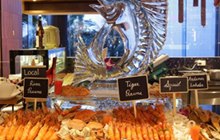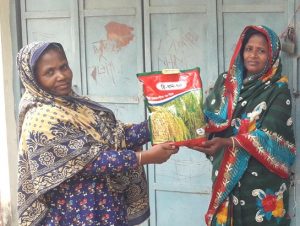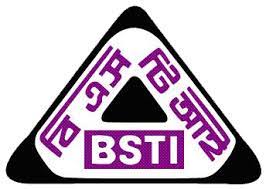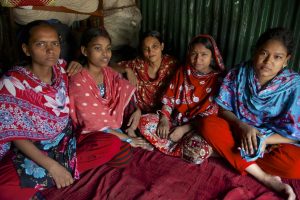by Clelia Daniel cdaniel@csr-asia.com and Janet Salem janet.salem@unep.org
Do I need to be vegan to eat responsibly? Does my seabass come with a side of slavery? Do I need to finish my plate?
On average, consumers take less than two seconds to decide on a product – and even less time in a busy buffet line at a conference lunch, leaving little time to process a multi-faceted decision for the environment and social responsibility. For those of us who want to ‘walk the talk’ of responsible consumption, the simple act of perusing a conference buffet can become a minefield of potential faux pas, particularly in front of our partners and clients.But what if we changed the business model from forcing consumers to choose, to make all choices sustainable? By letting the food do the talking, we can communicate about sustainable food systems without adding another session to the already packed conference agenda.
This September in Bangkok, CSR Asia teamed up with the UN Environment Programme, the Amari Watergate Bangkok and ONYX Hospitality Group, to offer a sustainable food experience for the 500 delegates of the CSR Asia Summit 2017. This was the biggest attempt to integrate sustainability concepts into catering in a conference of this scale in Thailand. A fitting opportunity, as the CSR Asia Summit was held on September 27th, which was World Tourism Day, and 2017 is the International Year of Sustainable Tourism for Development.
We will continue our sustainable food journey for future events. For businesses who wish to replicate or expand this type of catering option, this article shares our approach and learning experience. While surely not the ultimate recipe for a sustainable menu, it is a start:
Decide on your sustainable food stories. There are countless dimensions to sustainable food but we narrowed it down to those that we felt the most relevant for starting the conversation: responsible seafood, vegetarian and vegan protein, community-based livestock production, local and certified, menu design and food waste prevention. The hotel also added three additional criteria: local procurement, urban agriculture and apiculture.1 This innovative approach to continuous improvement initiated an “edible dialogue” about sustainability between CSR Asia, the hotel and its suppliers.
Cooperate on menu design. Cooperate with chefs to design menus and select the most important criteria for you and the hotel. This should be a shared decision, as the menu design requires ownership by the chefs who need to combine their creativity with sustainability criteria and economic considerations. The menu should also reflect sustainable choices that meet clients’ needs. Together with UN Environment, CSR Asia presented the Amari hotel with a framework for what sustainable menus could look like. We invited them to consider our focus areas and assess their current menu against the suggested criteria. The culinary team from the Amari hotel enthusiastically took this challenge forward and designed the first draft of the menu, both UNEP and CSR Asia commented on it twice. The hotel found new suppliers, some of which we helped them identify. The process spanned a month and a half, during which the catering team got to know the new suppliers and learned about their capacity to provide the quantity and quality of food needed to meet the hotel’s requirements. The head chef brought his own stories to the table about urban agriculture, honey from projects supporting communities and bee populations, healthy food and local food.
Source responsible seafood. Our priority was to select sustainably sourced varieties of seafood from local, certified and responsible small-scale suppliers. We chose the Fisherfolk Association, which uses environmentally and socially responsible business practices led by women and has a network of all fishing communities in the South of Thailand. They only fish for sustainable species, and their philosophy is to support environmentally friendly fishing methods. This means zero tolerance for use of illegal fishing tools, destructive fishing practices or sea floor trawling. All fish are organic and formaldehyde free (and tested). Fishermen and women earn fair and reliable income for what they produce.
Design a low carbon menu. Beef has one of the highest carbon footprints of all food, so we eliminated it from the menu. We only included sustainably sourced chicken, pork and seafood.
Combat food waste. When designing the menu, special attention was given to minimise food waste. All surplus food was donated to ThaiHarvest|SOS, a local food rescue non-profit. Involving charity organisations, or applying technology to measure and reduce waste, can cut down on uneaten food and costs. For example, the Anantara Hotel Siam uses food waste prevention technology that enables commercial kitchens to dramatically reduce food waste and operate more sustainable facilities. The system automatically tracks food waste using a set of digital scales and tablet which are connected to the cloud, making it quick and easy for chefs to measure food usage. The technology gives daily reports highlighting where waste is occurring thereby providing insight to make their operations more efficient and sustainable. The hotel reported that it has saved over 300 plated meals monthly.
Offer vegetarian and vegan protein. Dairy, eggs and plant-based protein play a similar nutritional role to meat, but with lower environmental footprints. To subconsciously shift demand, the hotel used the technique of “nudging” by giving participants an invisible cue to eat less meat. Some featured options included the Roasted Beetroot with Goat Cheese, and in the Indian section, the Dal Makhani.
Buy local and certified. We chose seasonal fruits and vegetables, and coffee sourced from environmentally certified producers. Ingredients were sourced locally wherever possible to reduce food miles and support local businesses. We also supported urban agriculture by using rooftop spirulina from Bangkok for the afternoon desserts (Whatpow).
Work with smallholders and women-led organisations. Connect your hotels with community-based farms. Smallholders find it hard to connect with markets and hotel chains due to network distribution challenges and lack of resources. At the Summit, both the chicken and pork came from community farms that raise livestock in a natural, chemical free and humane way. Sirin farm raises heritage livestock with ethical and environmental standards in mind. Honey, offered with tea and breakfast menu items, came from rural and urban apiculture farms that support ecosystems by maintaining bee populations, and communities through inclusive business models. Plan BEE is the flagship strategic community programme that ONYX designed to engage local low-income communities to help protect the Asian honeybee (Apis Cerena) against the threat of extinction. Each year a new community is provided training and start-up tools. The honey harvested is also sourced by ONYX brands for their restaurants and spa services. Plan BEE Honey is also available for purchase at the hotel gift shops and funds raised from sales help sustain the project.
Communicate your commitment. Use your meals as a way of communicating about your commitment to sustainability. Put up signs, inform your guests, make videos, and encourage feedback. We worked closely with the hotel staff on how to communicate these efforts to our delegates, on what to display the food items. We followed the philosophy of “experiential learning” which aims to increase empathy and information internalization and to raise awareness through the experience of eating – rather than through a presentation or report.
Create space for dialogue. CSR Asia’s Summit delegates enjoyed discussing what sustainable food means to them. There is no single solution, so encourage people to debate and avoid censoring debates or feedback. Feedback from our delegates was encouraging, with most rating satisfaction levels as very good or excellent (Figure 1). Delegates were satisfied with our efforts and gave us valuable tips for future endeavours. One critique was that buffets will never be sustainable, as they will always create excessive food waste. Participants would also have liked to read more food stories and found that our signs were too small, some delegates admitted that they did not notice the signs at all.
Throughout this journey, we learned a lot from the hotel and their chef – for example, the chef needs to pre-order all ingredients making it difficult for him to work with the last-minute changes sometimes presented by small-scale suppliers. This involves a wide range of factors that most households do not need to consider – cooking labour, storage, deliveries planning, the aesthetics of the buffet and customer expectations. We also learned that there is no better champion for sustainable food than an Executive Chef who lives and breathes quality ingredients.
This exercise has also strengthened dialogue along the hotel’s supply chain, encouraging farmers to talk to chefs, food and beverage managers to talk to NGOs like Oxfam, who supports the Fisherfolks Association or ThaiHarvest to reduce surplus food. We also hope to have strengthened the market for Asia’s growing green consumer market.
Explore buffet alternatives. Eco-business recently published an article on how the hospitality industry is contributing to the global food waste problem. One obvious solution was to seek alternative options to buffet style meals.
Adjust to sustainable procurement policies. Hotels and restaurants can modify their procurement policies to encourage systemic change beyond your facilities. Together with Oxfam, CSR Asia is coordinating a series of seafood and agribusiness roundtables to engage and help businesses commit to sustainable policies.
http://csr-asia.com/newsletter-a-sustainable-food-journey




